| dc.description.abstract | The work described in this thesis was based on the results from a research project called “Experimental Study Investigating Risks of Selected Amines” (ExSIRA). The aim of the project was to gain knowledge on amines released from a carbon capture and storage (CCS) plant and their toxicity on a vulnerable nitrogen sensitive environment. Aqueous solutions of low mass aliphatic amines like monoethanolamine (MEA), diethanolamine (DEA) and 2-amino-2-methyl-1-propanol (AMP) are commonly used in post combustion capture technology, to remove CO2 released from a fossil fuel fired power plant. The ExSIRA project simulated a worst case scenario release from a CCS plant by adding amines to experimental plots of an ombrotrophic raised bog at Smøla, Norway. The aim was to collect water and calculate a recovery of amines. However, no amines were found in the soil-water. The goal of the study in this thesis was to investigate two hypotheses connected to the fate of the amines, and validate two liquid chromatography mass spectrometry (LC-MS) methods developed by the Norwegian Institute for Air Research (NILU).
Method validation involved finding limits of detection (LOD) and quantification (LOQ), linearity, accuracy and precision of two analytical methods, in addition to determine the stability of analytes. One method analyzed the amines directly, while the other method analyzed amines indirectly through a derivative of dansyl chloride. None of the methods fulfilled all criteria’s set in the method validation plan. In general, the direct method was best suited for analysis of high concentration samples due to a greater linear range, while the indirect method was best suited for analysis of lower concentrations due to higher sensitivity and smaller linear range. Both methods contained some uncertainties regarding accuracy and precision. Despite these uncertainties, the validation of DEA was better with the direct method, while MEA and AMP gave better results with the indirect method. The stability test indicated that only MEA showed instability and possible degradation over time.
A leaching experiment in soil columns was conducted by Line Tau Strand at the Department of Environmental Sciences at NMBU in order to simulate the ExSIRA project at Smøla. The soil columns were added amines and drained by gravity. The leachate collected contained 11-23 % of the same amines added to the columns. The two hypothesis developed from the ExSIRA project said that amines could not be detected because of too much noise in the sample matrix, and/or because all amines were adsorbed to the soil solid phase. Both of these hypotheses were rejected. | nb_NO |
